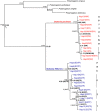Allopatric divergence of Stuckenia filiformis (Potamogetonaceae) on the Qinghai-Tibet Plateau and its comparative phylogeography with S. pectinata in China
- PMID: 26864465
- PMCID: PMC4750007
- DOI: 10.1038/srep20883
Allopatric divergence of Stuckenia filiformis (Potamogetonaceae) on the Qinghai-Tibet Plateau and its comparative phylogeography with S. pectinata in China
Abstract
In the aquatic genus Stuckenia, the wide geographic range of S. pectinata and S. filiformis make them suited for examination of topographic and climatic effects on plant evolution. Using nuclear ITS sequence and ten chloroplast sequences, we conducted comparative phylogeographical analyses to investigate their distribution regions and hybrid zones in China, and compare their phylogeographical patterns and demographical histories. These two species were allopatric in China. S. filiformis occurred only on the Qinghai-Tibet Plateau (QTP), whereas S. pectinata occupied a wide range of habitats. These two species formed hybrid zones on the northeastern edge of QTP. Most of the genetic variance of S. filiformis was between the southern and eastern groups on the QTP, showing a significant phylogeographic structure. The geographical isolations caused by the Nyenchen Tanglha Mountains and the Tanggula Mountains promoted intraspecific diversification of alpine plants on the QTP. This study revealed the lack of phylogeographic structure in S. pectinata, due to the continued gene flow among its distribution regions. The ecological niche modeling showed that the distribution ranges of these two herbaceous species did not contract too much during the glacial period.
Figures





Similar articles
-
Chloroplast phylogeny and phylogeography of Stellera chamaejasme on the Qinghai-Tibet Plateau and in adjacent regions.Mol Phylogenet Evol. 2010 Dec;57(3):1162-72. doi: 10.1016/j.ympev.2010.08.033. Epub 2010 Sep 7. Mol Phylogenet Evol. 2010. PMID: 20828627
-
Phylogeny and biogeography of Primula sect. Armerina: implications for plant evolution under climate change and the uplift of the Qinghai-Tibet Plateau.BMC Evol Biol. 2015 Aug 16;15:161. doi: 10.1186/s12862-015-0445-7. BMC Evol Biol. 2015. PMID: 26275399 Free PMC article.
-
Conserved DNA sequence analysis reveals the phylogeography and evolutionary events of Akebia trifoliata in the region across the eastern edge of the Tibetan Plateau and subtropical China.BMC Ecol Evol. 2024 Apr 23;24(1):52. doi: 10.1186/s12862-024-02243-0. BMC Ecol Evol. 2024. PMID: 38654171 Free PMC article.
-
Plant molecular phylogeography in China and adjacent regions: Tracing the genetic imprints of Quaternary climate and environmental change in the world's most diverse temperate flora.Mol Phylogenet Evol. 2011 Apr;59(1):225-44. doi: 10.1016/j.ympev.2011.01.012. Epub 2011 Feb 1. Mol Phylogenet Evol. 2011. PMID: 21292014 Review.
-
Species divergence with gene flow and hybrid speciation on the Qinghai-Tibet Plateau.New Phytol. 2022 Apr;234(2):392-404. doi: 10.1111/nph.17956. Epub 2022 Jan 30. New Phytol. 2022. PMID: 35020198 Review.
Cited by
-
Effects of highland environments on clonal diversity in aquatic plants: An interspecific comparison study on the Qinghai-Tibetan Plateau.Front Plant Sci. 2022 Oct 20;13:1040282. doi: 10.3389/fpls.2022.1040282. eCollection 2022. Front Plant Sci. 2022. PMID: 36340384 Free PMC article.
-
Influence of Mining and Vegetation Restoration on Soil Properties in the Eastern Margin of the Qinghai-Tibet Plateau.Int J Environ Res Public Health. 2020 Jun 16;17(12):4288. doi: 10.3390/ijerph17124288. Int J Environ Res Public Health. 2020. PMID: 32560083 Free PMC article.
-
Diverse range dynamics and dispersal routes of plants on the Tibetan Plateau during the late Quaternary.PLoS One. 2017 May 5;12(5):e0177101. doi: 10.1371/journal.pone.0177101. eCollection 2017. PLoS One. 2017. PMID: 28475607 Free PMC article.
-
Genetic diversity, population genetic structure and gene flow in the rare and endangered wild plant Cypripedium macranthos revealed by genotyping-by-sequencing.BMC Plant Biol. 2023 May 15;23(1):254. doi: 10.1186/s12870-023-04212-z. BMC Plant Biol. 2023. PMID: 37189068 Free PMC article.
-
Incorporating Genetic Diversity to Optimize the Plant Conservation Network in the Third Pole.Glob Chang Biol. 2025 Mar;31(3):e70122. doi: 10.1111/gcb.70122. Glob Chang Biol. 2025. PMID: 40110964 Free PMC article.
References
-
- Liu J. Q., Sun Y. S., Ge X. J., Gao L. M. & Qiu Y. X. Phylogeographical studies of plants in China: Advances in the past and directions in the future. J. Syst. Evol. 50, 267–275 (2012).
-
- Du F. K. et al. Direction and extent of organelle DNA introgression between two spruce species in the Qinghai-Tibetan Plateau. New Phyto. 192, 1024–1033 (2011). - PubMed
-
- Qiu Y. X., Fu C. X. & Comes H. P. Plant molecular phylogeography in China and adjacent regions: Tracing the genetic imprints of Quaternary climate and environmental change in the world’s most diverse temperate flora. Mol. Phylogenet. Evol. 59, 225–244 (2011). - PubMed
-
- Royden L. H., Burchfiel B. C. & van der Hilst R. D. The geological evolution of the Tibetan plateau. Science 321, 1054–1058 (2008). - PubMed
-
- Zhou S. Z., Wang X. L., Wang J. & Xu L. B. A preliminary study on timing of the oldest Pleistocene glaciation in Qinghai-Tibetan Plateau. Quatern. Int. 154–155, 44–51 (2006).
Publication types
MeSH terms
Substances
LinkOut - more resources
Full Text Sources
Other Literature Sources

